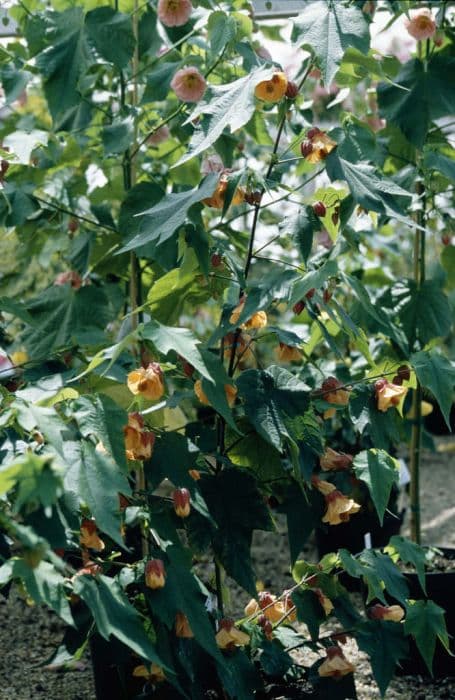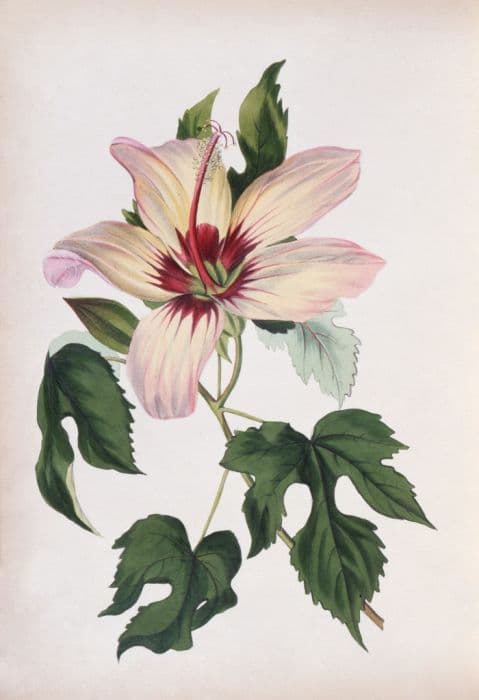Flowering Maple Abutilon pictum 'Thompsonii' (v)

ABOUT
The Abutilon pictum 'Thompsonii', commonly known as Thompson's flowering maple, is a striking ornamental plant renowned for its attractive foliage and showy flowers. The leaves of this variety are particularly eye-catching; they are variegated, meaning they possess areas of different colors. Typically, the green leaves exhibit splashes of yellow or even a golden hue, lending a mottled and often speckled appearance that can add visual intrigue to any garden space. Thompson's flowering maple blooms with bell-shaped flowers, which dangle delicately from slender stalks. The blossoms are usually a vibrant orange or sometimes a soft yellow, with prominent and contrasting veins that can be darker in color, adding depth and intricacy to the overall floral display. These colorful flowers are attractive to a variety of pollinators, including hummingbirds, and can lend a tropical air to the environment where the plant is grown. The overall shape of the plant tends to be bushy, with branching stems that allow it to spread out and present its foliage and flowers elegantly. The branches are relatively slender and can become somewhat woody over time. It is a plant that imparts a lush, almost exotic look wherever it is placed, and is often used in ornamental gardens for this reason. Its variegated leaves and vibrant flowers make it a real standout among garden plants.
About this plant
 Names
NamesFamily
Malvaceae.
Synonyms
Flowering Maple, Painted Indian Mallow, Red Vein Indian Mallow, Trailing Abutilon, Thompson's Abutilon, Variegated Abutilon.
Common names
Abutilon striatum, Abutilon thompsonii, Abutilon pictum, Sida picta, Abutilon pictum var. thompsonii, Abutilon thompsonii var. mariegiselle
 Toxicity
ToxicityTo humans
Flowering maple, the common name for Abutilon pictum 'Thompsonii', is not known to be toxic to humans. Ingesting parts of this plant should not lead to poisoning or produce harmful symptoms. However, individual sensitivities can vary, and it is generally advised to avoid ingesting parts of ornamental plants.
To pets
Flowering maple is also not known to be toxic to pets. It should not cause poisoning or adverse symptoms if a pet, such as a cat or dog, ingests parts of the plant. As with humans, it is still best to prevent pets from eating ornamental plants due to the potential for individual sensitivities or other non-toxic reactions like gastrointestinal upset.
 Characteristics
CharacteristicsLife cycle
Perennials
Foliage type
Evergreen
Color of leaves
Variegated
Flower color
Orange
Height
8-10 feet (2.4-3 meters)
Spread
6-8 feet (1.8-2.4 meters)
Plant type
Shrub
Hardiness zones
9
Native area
South America
Benefits
 General Benefits
General Benefits- Ornamental Value: Abutilon pictum 'Thompsonii', commonly known as Flowering Maple, has striking variegated leaves and bell-shaped flowers that add visual appeal to gardens and landscapes.
- Wildlife Attraction: The plant's flowers can attract pollinators such as bees and hummingbirds, benefiting the local ecosystem.
- Shade Tolerance: Flowering Maple can tolerate partial shade, making it versatile for different garden settings.
- Container Gardening: It adapts well to container culture, allowing it to be used on patios, balconies, and other confined spaces.
- Fast Growth: This cultivar tends to grow quickly, providing rapid gratification in terms of landscape development.
- Drought Resistance: Once established, Flowering Maple has a degree of drought resistance, reducing the need for frequent watering.
- Easy Propagation: It can be easily propagated from cuttings, making it cost-effective and simple to multiply plants for extensive planting or sharing with others.
 Medical Properties
Medical PropertiesThis plant is not used for medical purposes.
 Air-purifying Qualities
Air-purifying QualitiesThis plant is not specifically known for air purifying qualities.
 Other Uses
Other Uses- Flowering Maple can be used as a natural dye source. The flowers and leaves may be boiled to extract colorants for textile dyes.
- Ornamental screen or privacy hedge. Its dense foliage and fast-growing habit make it suitable for creating a living screen.
- Education and research. Botanists and horticulturists may use Flowering Maple for studies on plant growth habits and hybridization techniques.
- Bonsai plant. The Abutilon pictum 'Thompsonii' can be trained and pruned to create miniature tree forms for bonsai art.
- Eco-friendly confetti. Dried petals of the Flowering Maple can be used as biodegradable confetti for outdoor celebrations.
- Sensory gardens for the visually impaired. The textured leaves and bell-shaped flowers add a tactile element to gardens designed for the visually impaired.
- Photography and botanical illustration. The plant's striking appearance makes it a popular subject for artistic representation.
- Cultural symbolism. In some cultures, the Flowering Maple may be used in festive decorations as a symbol of beauty or abundance.
- Butterfly and hummingbird attraction. The plant can be included in gardens designed to attract and support pollinator species.
- Dried floral arrangements. Flowers and seed pods can be dried and used in long-lasting arrangements or crafts.
Interesting Facts
 Feng Shui
Feng ShuiThe Flowering Maple is not used in Feng Shui practice.
 Zodiac Sign Compitability
Zodiac Sign CompitabilityThe Flowering Maple is not used in astrology practice.
 Plant Symbolism
Plant Symbolism- Beauty in Subtlety: The Abutilon pictum 'Thompsonii', commonly known as the "Flowering Maple," has subtle yet intricate beauty, with its bell-shaped flowers and maple-like leaves, representing appreciation for the understated elegance in life.
- Protection: Its broad leaves are reminiscent of a canopy, symbolizing shelter and protection from life's metaphorical harsh elements.
- Adaptability: The Flowering Maple is versatile and can adapt to different environments, symbolizing the ability to thrive in various conditions and the importance of being resilient and flexible.
- Warmth: The warm coloring of the flower can symbolize a sunny disposition, hospitality, and the welcoming of guests.
- Domestic Happiness: With its homey, maple-like foliage and cozy appearance, the Flowering Maple represents the joy and contentment found in a well-loved home environment.
 Water
WaterThe flowering maple (Abutilon pictum 'Thompsonii') requires regular watering to keep the soil consistently moist but not waterlogged. During the growing season, water the plant thoroughly once the top inch of soil feels dry to the touch, which generally means once a week. Each watering session should involve slowly watering around the base of the plant until you have added approximately 1 to 1.5 gallons of water, depending on the size of the pot or the plant's location in the garden. Be cautious of over-watering and ensure good drainage to prevent root rot. During winter, reduce watering to every other week as the plant's growth slows down.
 Light
LightFor the flowering maple, bright, indirect light is optimal. This plant thrives near a southern or eastern facing window if grown indoors, where it receives plenty of light without being exposed to harsh direct sunlight. Outdoors, place the flowering maple in a spot where it can benefit from partial shade, especially shielded from the intense midday sun which can scorch the leaves.
 Temperature
TemperatureThe flowering maple prefers a temperate range of 60 to 75 degrees Fahrenheit, avoiding temperatures lower than 50 degrees or higher than 85 degrees. This temperature range supports its growth and flowering phases. Always protect the flowering maple from frost, as it is sensitive to extreme cold and cannot survive in temperatures that drop significantly below 50 degrees Fahrenheit.
 Pruning
PruningPrune the flowering maple to maintain its shape and encourage bushier growth, remove any dead or damaged branches, and promote more blooms. Pruning is best done in late winter or early spring before new growth begins. Cut back the stems by a third of their length, using clean and sharp pruning shears, and perform additional light pruning throughout the growing season to remove spent flowers and shape the plant as desired.
 Cleaning
CleaningAs needed
 Soil
SoilThe Flowering Maple (Abutilon pictum 'Thompsonii') thrives best in a well-draining soil mix consisting of loam, peat, and perlite or sand with a pH between 6.0 and 7.5 to provide the proper nutrients and drainage.
 Repotting
RepottingThe Flowering Maple should be repotted every 2-3 years or when it becomes root-bound to ensure continued growth and health.
 Humidity & Misting
Humidity & MistingThe Flowering Maple prefers high humidity levels, ideally between 50% to 60%, which promotes lush growth and vibrant blooms.
 Suitable locations
Suitable locationsIndoor
Place in bright, indirect light and keep soil moist.
Outdoor
Protect from strong winds; partial sun; keep soil moist.
Hardiness zone
9-11 USDA
 Life cycle
Life cycleAbutilon pictum 'Thompsonii' (v), commonly known as Thompson's Flowering Maple, begins its life cycle as a seed, which germinates in warm, moist soil conditions, sprouting into a seedling. The seedling then develops into a young plant with characteristic variegated leaves, often growing quickly with adequate water, light, and nutrients. As it matures, the Thompson's Flowering Maple enters a vegetative stage where the growth of stems and leaves accelerates, and the plant establishes a robust root system. Following the vegetative phase, it enters the flowering stage, producing bell-shaped, pendulous flowers that offer ornamental value and may attract pollinators. If pollinated, the flowers will develop into seedpods containing seeds that, once mature, can be dispersed to give rise to new plants. Throughout its life, cultural practices such as pruning, fertilizing, and pest management are essential for sustaining the plant's health and promoting continuous growth and flowering.
 Propogation
PropogationPropogation time
Spring-Early Summer
The Abutilon pictum 'Thompsonii', commonly known as Flowering Maple 'Thompsonii', can be effectively propagated through semi-hardwood cuttings. This is typically done during the late spring or early summer when the plant has abundant new growth. To propagate, you should choose a healthy stem and cut a 4 to 6-inch (approximately 10 to 15 cm) section just below a leaf node. Remove the leaves from the lower half of the cutting and dip the cut end into a rooting hormone to encourage root development. The cutting should then be planted in a pot filled with a moistened mixture of peat and perlite or sand to provide good drainage. It's crucial to keep the cutting in a warm, humid environment, such as under a plastic dome or in a mini greenhouse, ensuring that the soil is consistently moist but not waterlogged. Roots should begin to form within a few weeks, at which point the new Flowering Maple 'Thompsonii' plant can be gradually acclimated to normal growing conditions.









